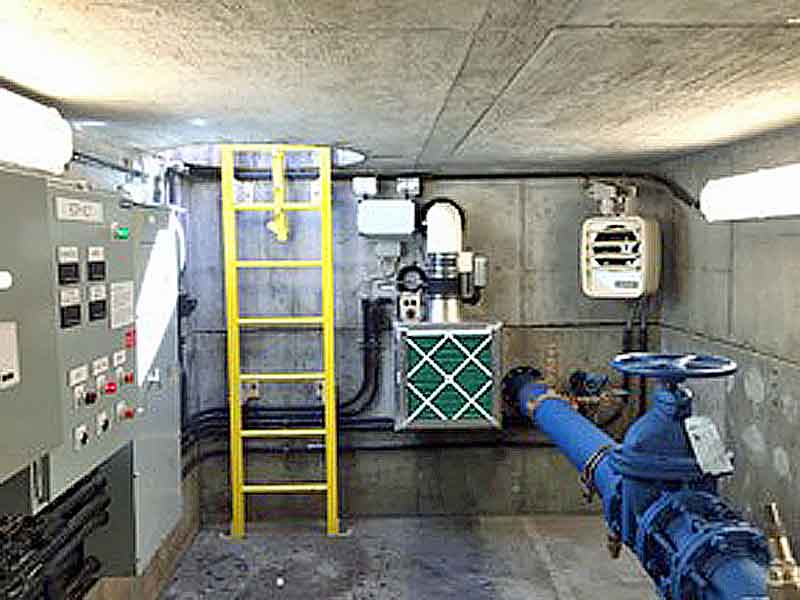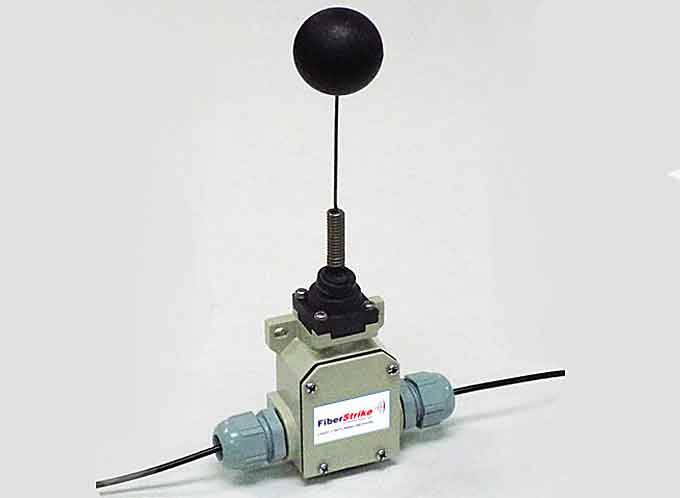
By Matt Krutch, Applications Engineer, Cleveland Electric Laboratories (CEL)
High-security threats to our nation’s critical infrastructure are a serious concern for military installations, telecom providers, data centers, utility companies, municipalities, stadiums, and secure campus environments.

Unauthorized entry into these and other critical infrastructure locations are of great concern to operators throughout the security industry.
Breaches of entry points such as exterior doorways, maintenance hatches, underground vaults and manholes, all of which are often unprotected by physical sensors, are a common occurrence and need to be managed more closely.
These locations are often in remote locations and harsh environments where it can be difficult or impossible to install sensors typically used to secure buildings and homes.

There have been countless examples where obtaining access to these sensitive locations has resulted in theft of physical goods, destruction of property and individuals being able to commit various types of crimes.
Cyber crime is also currently a common occurrence.
Stories of hackers defeating the cyber security of top companies are breaking at an increasing rate.
There is a deluge of connected devices that are simultaneously flooding the market.
 The Internet of Things (IoT) is growing exponentially with an estimated 30 billion connected devices expected by the year 2020.
The Internet of Things (IoT) is growing exponentially with an estimated 30 billion connected devices expected by the year 2020.
This will further complicate security because just as proprietary networks can be attacked and exploited, on network security solutions are vulnerable as well.
How can we best secure our most critical locations?
Legacy systems are effective and have proven success in buildings and homes but lack the right sensors to protect the difficult to monitor locations due to limited range, they run in parallel, or in those environments can be spoofed or defeated.
Industry-standard systems employ low-voltage, normally open or normally closed circuits that activate a relay when there is a change in some state of the sensor.
 The most common are magnetic reed switches used to secure doors and windows.
The most common are magnetic reed switches used to secure doors and windows.
These sensors need to be directly connected by wires to the security relay panel and can require a stringent maintenance program.
The systems themselves are known and proven.
There are companies in every city that can install and maintain the systems and security professionals at secure locations are familiar with their operation.
A new generation of security systems is now available that can be used over long distances to secure locations that have not been possible to monitor until now.
Using fiber optics, we can now use light to detect the states of switches.
 Optical fiber can be used to transmit and receive signals over miles and is completely passive.
Optical fiber can be used to transmit and receive signals over miles and is completely passive.
It does not require any electricity at the sensing location and is immune to EMI and RFI.
It is not detectable using a metal detector.
Fiber systems can use long serial runs of many sensors over a single optical fiber each of which have a unique optical signature that cannot be spoofed or bypassed.
Current optically-based systems employ a wide variety of technologies to achieve this, but these benefits come at a cost.
Most of these require dedicated computers or even a rack of equipment, specialized user interfaces or expensive and often customized software to be integrated into an existing system.
There aren’t many industry standards for this technology either.

These systems require extra training for operators and maintenance usually must be done by the company that created the system, not to mention many of them are wildly expensive and almost impossible to justify as an expense.
Many of these systems require a PC to run the software and hardware along with a network connection.
This decreases their effectiveness because they are left open to cyber-attack through network cards, USB ports, Bluetooth and Wi-Fi cards.
Because of cost, complexity and customization, the market has been slow to adopt this highly-effective yet challenging technology.
(FiberStrike® consists of two distinctly different technology groups: Courtesy of Cleveland Electric Laboratories and YouTube. Posted on Apr 13, 2018.)
To be secure in the future we must look to the past.
This can be done by coupling high-tech sensing devices with increased capability with field-proven infrastructure that does not rely on any connectivity.
The CEL Solution:
The FiberStrike® LCM-2500 Discrete Relay Interface (DRI) developed and manufactured by Cleveland Electric Laboratories is a state-of-the-art solution for monitoring the security status of virtually any access portal.
- It does not require a PC and has no network connectivity.
- The LCM-2500 integrates seamlessly into existing security systems through up to 64 dry contact relays.
- It is no different than wiring in a standard electrical sensor to an existing security panel and programming the system in the same way.
- The configurable relays can be controlled to respond to changes in one or more sensors.

- The sensors are connected to optical connectors on the box.
- Each optical channel utilizes one strand of SM fiber with several uniquely addressed switches installed in series.
- All switches on the system are monitored continuously and simultaneously, and intrusion events are immediately reported by the DRI.
- Switches may be located up to 16km away from the equipment location.
- The DRI is designed to display and control alarm event switching for up to 64 fiber optic tamper switches.
- When a switch is opened or closed – the associated dry contact relay output activates in less than one second.
- Custom configurations are available for larger sensor count systems as well as Physical Security Information Management (PSIM) software-based systems where C3 or C4 integration is required.

The FiberStrike® LCM-2500 Discrete Relay Interface (DRI) is an excellent value that provides speed of light response to intrusion events across up to 64 locations with immunity to cyber-hacking while making very efficient and effective use of available unused fiber, further reducing installation costs.
1.Nordrum, Amy (18 August 2016). “Popular Internet of Things Forecast of 50 Billion Devices by 2020 Is Outdated”. IEEE.
Cleveland Electric Laboratories Named a Finalist in 2018 ‘ASTORS’ Homeland Security Awards Program
AST focuses on Homeland Security and Public Safety Breaking News, the Newest Initiatives and Hottest Technologies in Physical & IT Security, essential to meeting today’s growing security challenges.
 The 2018 ‘ASTORS’ Homeland Security Awards Program, is organized to recognize the most distinguished vendors of Physical, IT, Port Security, Law Enforcement, Border Security, First Responders, (Fire, EMT, Military, Support Services Vets, SBA, Medical Tech) as well as the Federal, State, County and Municipal Government Agencies – to acknowledge their outstanding efforts to ‘Keep our Nation Secure, One City at a Time.’
The 2018 ‘ASTORS’ Homeland Security Awards Program, is organized to recognize the most distinguished vendors of Physical, IT, Port Security, Law Enforcement, Border Security, First Responders, (Fire, EMT, Military, Support Services Vets, SBA, Medical Tech) as well as the Federal, State, County and Municipal Government Agencies – to acknowledge their outstanding efforts to ‘Keep our Nation Secure, One City at a Time.’
As an ‘ASTORS’ Finalist, CEL, is competing against the industry’s leading providers of Innovative Intrusion Detection & Prevention Solutions.
To Learn More about the ‘ASTORS’ Homeland Security Awards Program, see 2017 ‘ASTORS’ Homeland Security Award Winners Honored at ISC East.

Over 100 distinguished guests from National, State and Local Governments, and Industry Leading Corporate Executives from companies allied to Government, gathered from across North America and the Middle East to be honored from disciplines across the Security Industry in their respective fields which included representatives from:
 The Department of Homeland Security(DHS) Science and Technology Directorate (S&T)
The Department of Homeland Security(DHS) Science and Technology Directorate (S&T)- U.S. Customs and Border Protection
- The Department of Justice
- The Security Exchange Commission
- State and Municipal Law Enforcement Agencies
- The Royal Canadian Mounted Police
- Leaders in Private Security
The highlight of the 2018 AST Homeland Security Awards Season is the 2018 ‘ASTORS’ Awards Presentation Luncheon to honor Nominees, Finalists and Winners on November 14, 2018 at ISC East 2018 at the Jacob Javits Exhibition Center in New York City.

Alan Seymour, PhD of Cleveland Electric Laboratories receiving 2017 ‘ASTORS’ Award at 2017 ‘ASTORS’ Award Presentation Luncheon Good luck to Cleveland Electric Laboratories on becoming a Winner of the 2018 American Security Today’s Homeland Security Awards Program!
To learn more about CEL’s FiberStrike Discrete Relay Interface, please visit http://www.clevelandelectriclabs.com/products/fosensors/.

Please join us in Recognizing these Industry-Leading Firms for their Outstanding Product Development Achievements, Exciting New Technologies and Innovative Education Programs to address the growing Homeland Security Threats our Nation is facing.


















